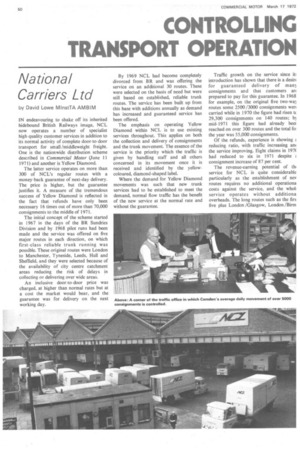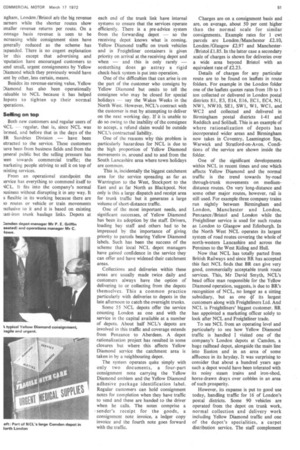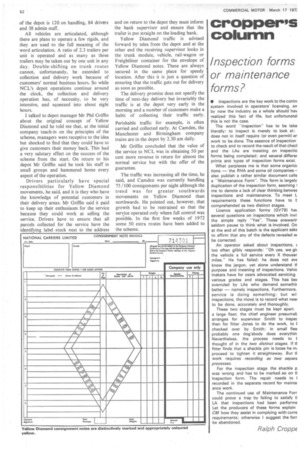CONTROLLING TRANSPORT OPERATION
Page 52

Page 53

Page 54

If you've noticed an error in this article please click here to report it so we can fix it.
National Carriers Ltd
by David Lowe MinstTA AM RIM IN endeavouring to shake off its inherited hidebound British Railways image, NCL now operates a number of specialist high-quality customer services in addition to its normal activity of complete door-to-door transport for small /middleweight freight. One is the nationwide distribution scheme described in Commercial Motor (June 11 1971) and another is Yellow Diamond The latter service operates on more than 300 of NC L's regular routes with a money-back guarantee of next-day delivery. The price is higher, but the guarantee justifies it. A measure of the tremendous success of Yellow Diamond is reflected in the fact that refunds have only been necessary 16 times out of more than 70,000 consignments to the middle of 1971.
The initial concept of the scheme started in 1967 in the days of the BR Sundries Division and by 1968 pilot runs had been made and the service was offered on five major routes in each direction, on which first-class reliable trunk running was possible. These original routes were London to Manchester, Tyneside, Leeds, Hull and Sheffield, and they were selected because of the availability of city centre catchment areas reducing the risk of delays in collecting or delivering over wide areas.
An inclusive door-to-door price was charged, at higher than normal rates but at a cost the market would bear, and the guarantee was for delivery on the next working day. By 1969 NCL had become completely divorced from BR and was offering the service on an additional 30 routes. These were selected on the basis of need but were still based on established, reliable trunk routes. The service has been built up from this base with additions annually as demand has increased and guaranteed service has been offered The emphasis on operating Yellow Diamond within NCL is to use existing services throughout. This applies on both the collection and delivery of consignments and the trunk movement. The essence of the service is the priority which the traffic is given by handling staff and all others concerned in its movement once it is received and identified by the yellowcoloured, diamond-shaped label.
Where the demand for Yellow Diamond movements was such that new trunk services had to be established to meet the demand, normal flow traffic has the benefit of the new service at the normal rate and without the guarantee. Traffic growth on the service since it introduction has shown that there is a desin for guaranteed delivery of man3 consignments and that customers an prepared to pay for this guarantee. In 1968 for example, on the original five two-wal routes some 2500/3000 consignments wen carried while in 1970 the figure had risen tt 29,300 consignments on 140 routes; b1 mid-1971 this figure had already bee' reached on over 300 routes and the total foi the year was 55,000 consignments.
Of the refunds, experience is showing 1 reducing ratio, with traffic increasing ant the service improving. Eight claims in 1971 had reduced to six in 1971 despite consignment increase of 87 per cent.
The revenue-earning potential of thi service for NCL is quite considerable particularly as the establishment of nev routes requires no additional operationa costs against the service, and the what service operates without additiona overheads. The long routes such as the firs five plus London /Glasgow, London /Birm
ngham, London /Bristol are the big revenue earners while the shorter routes show ;mailer revenue returns per route. On a :onnage basis revenue is seen to be ncre,asina while consignment sizes have generally reduced as the scheme has ,txpanded. There is no cogent explanation 'or this except that advertising and -eputation have encouraged customers to cend small, urgent consignments by Yellow Diamond which they previously would have ient by other, less certain, means.
Besides its revenue-earning value, Yellow Diamond has also been operationally ra1uable to NCL because it has helped depots to tighten up their normal verations.
Selling on top
Both new customers and regular users of \ICL -regular, that is, since NCL was 'ormed, and before that in the days of the 3R Sundries Division . — have been ittracted to the service. These customers lave been from business fields and from the general public but the selling pressure has teen towards commercial traffic; the narketina people striving to sell it on top of !xisting services.
From an operational standpoint the ;ervice has everything to commend itself to \IC L. It fits into the company's normal tusiness without disrupting it in any way. It s flexible in its working because there are to routes or vehicle or train movements occlusive to it and it is based on existing :ast-iron trunk haulage links. Depots at
each end of the trunk link have internal systems to ensure that the services operate efficiently. There is a pre-advice system from the forwarding depot — so the receiving depot knows what is coming. Yellow Diamond traffic on trunk vehicles and in Freightliner containers is given priority on arrival at the receiving depot and when — and this is only rarely — something does go astray a rigid check-back system is put into operation.
One of the difficulties that can arise is on the part of the customer who consigns by Yellow Diamond but omits to tell the consignee who may be closed for special holidays say the Wakes Weeks in the North West. However, NCL's contract with the customer is met by attempting to deliver on the next working day. If it is unable to do so owing to the inability of the consignee to accept, a refund claim would be outside NCL's contractual liability.
One of the reasons why this problem is particularly hazardous for NCL is due to the high proportion of Yellow Diamond movements in, around and to and from the South Lancashire area where town holidays are common.
This is, incidentally the biggest catchment area for the service spreading as far as Warrington to the West, Stockport to the East and as far North as Blackpool. Not only is this a large dispatch and receipt area for trunk traffic but it generates a large volume of short-distance traffic.
One of the most important needs, and significant successes, of Yellow Diamond has been its adoption by the staff. Drivers, loading bay staff and others had to be impressed by the importance of giving priority to parcels bearing Yellow Diamond labels. Such has been the success of the scheme that local NCL depot managers have gained confidence in the service they can offer and have widened their catchment areas.
Collections and deliveries within these areas are usually made twice daily and customers always have the option of delivering to or collecting from the depots themselves. This a common practice particularly with deliveries to depots in the late afternoon to catch the overnight trunks.
Some 55 NCL depots offer the service counting London as one and with the service in the capital available at a number of depots. About half NCL's depots are involved in this traffic and coverage extends from Penzance to Aberdeen. A depot rationalization project has resulted in some closures but where this affects Yellow Diamond service the catchment area is taken in by a neighbouring depot.
The system operates quite simply with only two documents, a four-part consignment note carrying the Yellow Diamond emblem and the Yellow Diamond adhesive package identification label. Regular customers can hold consignment notes for completion when they have traffic to send and these are handed to the driver when he calls. The notes comprise a sender's receipt for the goods, a consignment note invoice, a ledger copy invoice and the fourth note goes forward with the traffic. Charges are on a consignment basis and are, on average, about 50 per cent higher than the normal scale for similar consignments. Example rates for 1 cwt parcels are London /Manchester £2.10, London /Glasgow £2.97 and Manchester/Bristol £1.85. In the latter case a secondary scale of charges is shown for deliveries over a wide area beyond Bristol with an equivalent rate of £2.23.
Details of charges for any particular route are to be found on leaflets in route folders. For example in the London folder one of the leaflets quotes rates from llb to 1 ton collected or delivered in London postal districts El, E3, E14, E16, Ed, EC4, NI, NW1, NW10, SEI, SW!, WI, WC1, and WC2 and collected and delivered in Birmingham postal districts 1-41 and Redditch and Solihull. This is an example of where rationalization of depots has incorporated wider areas and Birmingham now takes in Coventry, Leamington Spa, Warwick and Stratford-on-Avon. Conditions of the service are shown inside the folder.
One of the significant developments within NCL in recent times and one which affects Yellow Diamond and the normal traffic is the trend towards by-road through-trunk movements on mediumdistance routes. On very long-distance and some other major routes, however, rail is still used. For example three company trains run nightly between Birmingham and London, Manchester and London, Penzance/Bristol and London while the Freightliner service is used for such routes as London to Glasgow and Edinburgh. In the North West NCL operates its largest system of road routes covering the whole of north-western Lancashire and across the Pennines to the West Riding and Hull.
Now that NCL has totally parted from British Railways and since BR has accepted this fact NCL finds that BR can give very good, commercially acceptable trunk route services. This, Mr David Smyth, NCL's head office man responsible for the Yellow Diamond operation, suggests, is due to BR's recognition of NCL, no longer as a sitting subsidiary, but as one 4f its largest customers along with Freightliners Ltd. And NCL is Freightliners' biggest customer. BR has appointed a marketing officer solely to look after NCL and Freightliner trade.
To see NCL from an operating level and particularly to see how Yellow Diamond traffic is handled I visited one of the company's London depots at Camden, a huge railhead depot, alongside the main line into Euston and in an area of some affluence in its heyday. It was surprising to consider that about a hundred years ago such a depot would have been tolerated with its noisy steam trains and iron-shod, horse-drawn drays over cobbles in an area of such prosperity.
However, its expanse is put to good use today, handling traffic for 16 of London's postal districts. Some 90 vehicles are operated from the depot on trunk work, normal collection and delivery work including Yellow Diamond traffic and one of the depot's specialities, a carpet distribution service. The staff complement of the depot is 120 on handling, 84 drivers and 38 admin staff.
All vehicles are articulated, although there are plans to operate a few rigids, and they are used to the full meaning of the word articulation. A ratio of 2.3 trailers per unit is operated and as many as three trailers may be taken out by one unit in any day. Double-shifting on trunk routes cannot, unfortunately, be extended to collection and delivery work because of customers' normal business hours. So while NC L's depot operations continue around the clock, the collection and delivery operation has, of necessity, to be very intensive, and squeezed into about eight hours.
I talked to depot manager Mr Phil Griffin about the original concept of Yellow Diamond and he told me that, at the initial company teach-in on the principles of the scheme, managers were receptive to the idea but shocked to find that they could have to give customers their money back. This had a very salutary effect on the success of the scheme from the start. On return to his depot Mr Griffin said he took his staff in small groups and hammered home every aspect of the operation.
Drivers particularly have special responsibilities for Yellow Diamond movements, he said, and it is they who have the knowledge of potential customers in their delivery areas. Mr Griffin said it paid to keep up their enthusiasm for the service because they could work at selling the service. Drivers have to ensure that all parcels collected for the service have the identifying label stuck next to the address and on return to the depot they must inform the bank supervisor and ensure that the trailer is put straight on the loading bank.
Yellow Diamond traffic is advised forward by telex from the depot and at the other end the receiving supervisor looks in the trunk module, vehicle, rail-wagon or Freightliner container for the envelope of Yellow Diamond notes. These are always secured in the same place for speedy location. After this it is just a question of ensuring that the traffic gets out for delivery as soon as possible.
The delivery promise does not specify the time of next-day delivery but invariably the traffic is at the depot very early in the morning and a number of customers make a habit of collecting their traffic early.
Perishable traffic for example, is often carried and collected early. At Camden, the Manchester and Birmingham company trains are in the depot by 2.30 am daily.
Mr Griffin concluded that the value of the service to NC L was in obtaining 50 per cent more revenue in return for almost the normal service but with the offer of the guarantee.
The traffic was increasing all the time, he said, and Camden was currently handling 75/100 consignments per night although the trend was for greater southwards movements on Yellow Diamond than northwards. He pointed out, however, that growth had to be restrained so that the service operated only where full control was possible. In the first few weeks of 1972 some 50 extra routes have been added to the scheme.










































































































